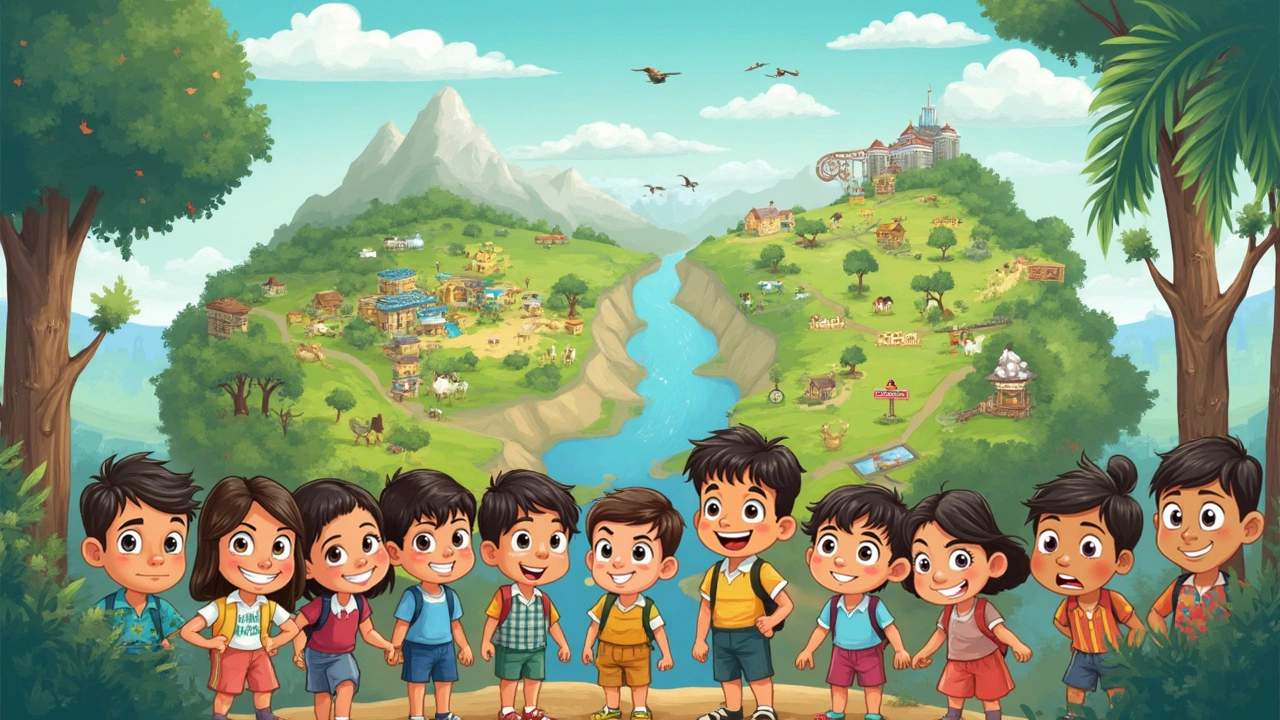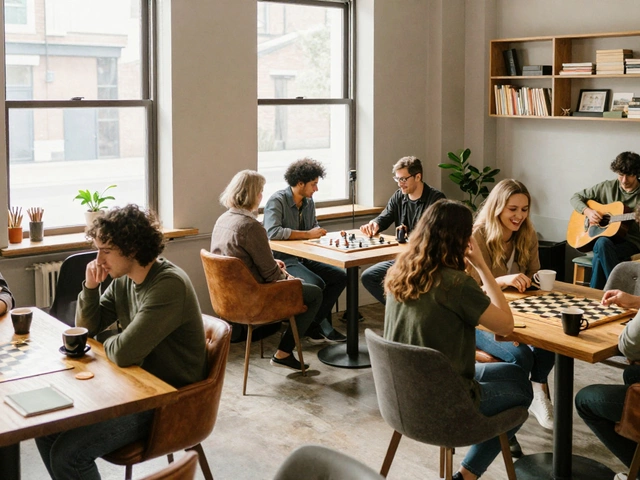Most people don’t stop to think about all the different environments shaping their lives. Yet, knowing what they are can actually make a difference—whether you care about your health, work, or the planet. Ever found it hard to concentrate in a noisy place or felt recharged after a walk in the park? That's your environment in action.
There isn’t just one type of environment out there. In fact, there are five main ones, and each has its own impact on our daily lives. These environments don’t just affect humans, either. Wildlife, plants, apps on your phone, and even your friendships—they all exist in their own environments, often mixing together.
If you’re interested in helping the planet or just want to create a better vibe at home, understanding these types is the first step. Stick around to find out exactly what they are, some surprising facts, and small steps you can take to make a difference starting today.
- Natural Environment: The Foundation of Life
- Built Environment: Where We Live and Work
- Social Environment: Connections and Communities
- Cultural Environment: Traditions and Beliefs
- Virtual Environment: Life in the Digital World
- How They All Interact & What You Can Do
Natural Environment: The Foundation of Life
When people talk about the natural environment, they mean everything that exists without much help from humans. We're talking about forests, oceans, rivers, mountains, soil, and the air we breathe. This environment supports all life on Earth. Think of it as the raw material for everything—food, clean water, even the oxygen in your lungs.
The natural environment is basically the world's giant life-support system. About 71% of the Earth's surface is covered by water, and most of that is saltwater in the oceans. Rainforests—like the Amazon—produce around 20% of the world’s oxygen. Even city dwellers rely on the natural world, since farms, forests, and water sources are behind every meal and drink you have.
This environment is made up of two main parts:
- Biotic factors: All living things—plants, animals, fungi, bacteria
- Abiotic factors: Non-living stuff—like sunlight, temperature, soil, air, and water
Every time you hear about endangered species or climate change, it's usually connected to the natural environment. Deforestation, plastic pollution, and greenhouse gases are just a few threats messing with this balance. In fact, scientists say we’ve lost about one-third of the world’s forests in the last 10,000 years—mostly to agriculture and cities. That’s not just sad for animals like orangutans; it matters for people because forests store carbon and fight climate change for us.
If all this makes you want to help, here’s something simple: pick up trash on your next hike or use less plastic at home. Even small changes add up. Nature isn’t some far-off thing—it’s your backyard, your favorite park, even the patch of weeds growing in a city crack. Every little bit you do to keep it healthy comes back to help you, too.
| Natural Environment Fact | Why It Matters |
|---|---|
| 71% of Earth's surface is water | Vital for survival, climate, and food systems |
| 20% of world oxygen from rainforests | Essential for breathing and a stable climate |
| One-third of forests lost in 10,000 years | Impacts wildlife, climate, and resources |
Built Environment: Where We Live and Work
The built environment is everything humans have made, from your house to highways to city parks. It covers schools, stores, factories, sidewalks—the whole setup of places people live, work, and hang out. Unlike forests or oceans, this stuff didn’t come from nature; it’s all people-powered.
Ever wondered how much time you really spend indoors? Studies from the EPA say Americans spend about 90% of their lives inside buildings. That means the quality of our built spaces can seriously impact our health and happiness. Good lighting, proper ventilation, and access to green areas matter more than most of us realize.
Here are a few basics the built environment covers:
- Homes and apartments
- Office buildings
- Roads and highways
- Parks and sports fields
- Shopping centers
- Public transportation systems like buses and trains
One big problem? Pollution and energy use. For example, buildings use about 40% of the world’s energy every year. That means even small tweaks—like better insulation, LED lights, or using public transport—can make a difference for the environment and your wallet too.
| Aspect | Impact |
|---|---|
| Energy Use (Global Buildings) | ~40% of annual world energy |
| Urban Green Space (City Avg.) | Less than 10% land in big cities |
| Commute Time (USA Avg.) | ~27 minutes one way |
There’s an extra angle too: mental health. Exposure to light, fresh air, and even a view of some trees can boost your mood. Urban planners are starting to build more parks and bike lanes for this reason—to make city living feel a bit less like living in a box.
So what can you do? Start local. Add a house plant, open a window, swap to LED bulbs, or join a community cleanup. Even these small actions shape the bigger picture of your built environment and the planet’s future.
Social Environment: Connections and Communities
The social environment shapes who you are, how you think, and what you value. It’s basically the web of people and groups you interact with—family, friends, neighbors, classmates, coworkers, even people you see at your favorite coffee shop. These connections give you a sense of belonging (or sometimes, exclusion) and create the norms you follow every day.
Researchers have found that your social circle can actually affect your health and happiness. For example, a Harvard study tracked people for over 75 years and found that strong relationships are key for long-term happiness, even more than money or fame. This shows just how powerful your social environment really is. Networks of trust and support help lower stress, boost mental health, and even increase life expectancy.
But the social environment isn’t just about individuals—it’s also about communities. Think schools, clubs, workplaces, churches, and volunteer groups. These organizations help shape shared values and provide safety nets when times get rough.
Ever heard about “social capital”? That’s a fancy term for the resources you get from being connected—like getting a job tip from a friend, or having someone help you move house. Areas with high social capital usually have lower crime rates and healthier populations.
- Getting involved in community groups can help you pick up new skills and meet people from different backgrounds.
- Just saying hello to neighbors or coworkers builds trust and can make your daily life less stressful.
- If you’re feeling left out, joining a local club or online group around something you enjoy can make a big difference.
Here’s a quick look at how the social environment stacks up in different ways:
| Factor | Positive Impact | Negative Impact |
|---|---|---|
| Close-Knit Community | Lower stress, more support | Pressure to conform |
| Diverse Social Networks | More opportunities | Possible misunderstandings |
| Isolation | — | Higher risk of anxiety, depression |
If you want to boost your own social environment, start small. Say hi to new people, offer help when you can, and don’t be afraid to ask for support. Small actions add up to a more positive community—and a better daily experience for everyone.

Cultural Environment: Traditions and Beliefs
So, what exactly is a cultural environment? It’s basically the mix of beliefs, practices, values, languages, and habits that shape our lives—often without us even noticing. This environment isn’t about geography, but about how people think and act together. When you celebrate holidays, follow family rules, or even decide how to greet your neighbor, that’s the cultural environment at play.
Let’s get specific. In Japan, taking off your shoes before entering a home is just normal—try doing that in some American homes and people are confused. Around the world, traditions like Diwali in India or Carnival in Brazil have deep roots, and they influence everything from the food people eat to the way they interact with nature. These things aren’t just “nice to have”—they actually impact how communities use resources, protect local wildlife, and even design cities.
If you’re curious about just how much culture can shape choices, look at recycling habits. People in Germany separate waste into at least five bins: paper, plastic, glass, organics, and “rest.” Compare that to the U.S., where single-stream recycling is still a norm in many places. That difference? It’s all about what each society values and expects—proof that traditions and beliefs actually change the way people treat their environments.
Check out a few ways the cultural environment pops up in everyday life:
- School systems: In Finland, playtime is a huge part of early education, while other places are stricter with academics.
- How people get around: Copenhagen’s bike culture compared to the car-heavy lifestyle in many U.S. cities.
- Food choices: Religious or cultural beliefs can decide what foods are “off-limits” or how food is shared.
Cultural environments aren’t set in stone, either. They change—think about how the internet and TV have made the world’s music, languages, and brands super connected. It’s not all good news: This can sometimes erase local cultures, but it also means more people learn new habits. For example, Earth Hour, a single event about saving energy, started in Sydney but now millions join worldwide.
Feeling stuck or want to make an impact? Start small: try a new tradition that’s good for the planet, like Meatless Mondays or joining a neighborhood cleanup. Tiny changes like these can ripple out and shift beliefs and habits over time—not just for you, but for your whole community.
Virtual Environment: Life in the Digital World
If you’ve ever lost yourself scrolling through your phone, joined in a video call, or played a game online, you’re right in the middle of a virtual environment. This type of environment is all about digital spaces where we work, hang out, and sometimes even learn. It's where emails, social media, streaming, and remote teamwork come together. The shift really picked up speed during the pandemic, with more people working and studying online than ever before—almost 60% of the world’s population now uses the internet, based on recent data from 2024.
Virtual environments are more than just websites and apps. Think about collaborative workspaces like Google Docs, video game worlds such as Minecraft, or even online forums where communities share advice. These spaces connect billions, break down physical limits, and let people connect or work from anywhere. But there’s a flip side too: screen fatigue, privacy worries, or the stress of being “always online.”
Here's a quick look at everyday virtual environments you might use:
- Social media platforms (like Instagram or TikTok)
- Virtual meeting rooms (Zoom, Microsoft Teams)
- Online classrooms (Google Classroom, Coursera)
- Gaming worlds (Roblox, Fortnite)
- Cloud storage and work tools (Dropbox, Slack)
Staying safe in these spaces is huge. Make strong passwords, use two-factor authentication, and watch out for phishing or scams. If you ever feel burned out from too much screen time, it helps to set time limits or turn off notifications.
Environmental groups are even showing up in these digital places—using virtual environments to share tips, organize clean-ups, and educate people quicker than before. Some groups even host “virtual forest” planting events, where you sponsor a tree for every online action.
Here’s a quick comparison of how people use virtual environments today:
| Activity | % of Users (2024) |
|---|---|
| Social media | 73% |
| Remote work/learning | 41% |
| Online gaming | 32% |
| Online shopping | 75% |
Life in the digital world isn’t going away. Mixing some good habits—like digital detox days and checking your privacy settings—can help you get the best out of virtual spaces and avoid the stress.
How They All Interact & What You Can Do
The five types of environments aren’t stuck in their own bubbles. Your natural environment and your built environment overlap everywhere you look. Think about city parks: trees and grass (natural) sit right next to sidewalks and buildings (built). Even more, our habits in one environment spill into others. If your neighborhood is safe and has green spaces, you’re probably walking more and even chatting with neighbors—linking natural, built, and social environment all in one afternoon.
Here's another real-world mix: cultural festivals held in stadiums or town squares. These events turn cultural and social environments into something buzzing, and they use the built environment to bring people together. Even your phone is a connection point; your virtual environment pulls in friends, news, and trends from every corner of the world, often shaping your days just as much as your physical spaces.
Studies from the World Health Organization show cities with better access to natural spaces lower stress for people and even cut down health problems like high blood pressure. And online, positive social interactions reduce loneliness, especially among younger folks who spend time in both real and digital worlds. Take a look at the impact:
| Environment Type | Positive Impact | Common Risk |
|---|---|---|
| Natural | Lower stress, better air | Deforestation, pollution |
| Built | Accessibility, safety | Overcrowding |
| Social | Support, belonging | Isolation |
| Cultural | Identity, meaning | Loss of traditions |
| Virtual | Convenience, connections | Misinformation |
So, what can you actually do to make things better across these environments? Here are some hands-on tips:
- Add a plant to your home or workspace. It’s a quick natural boost and helps clean the air.
- Get involved locally—maybe join or start a community clean-up. You'll strengthen both the built and social environment.
- Set phone limits or unplug for a few hours daily. Give your mind a break from the virtual world and experience the real one more deeply.
- If you’re part of any cultural groups, help organize an event to keep traditions alive and build community.
- Speak up about city planning (like more parks or crossings) at local meetings. Small voices can shift the future of your town's built environment.
The trick is to notice how each environment plays off the others. A few small changes now can make life better not just for you, but for your whole community.






